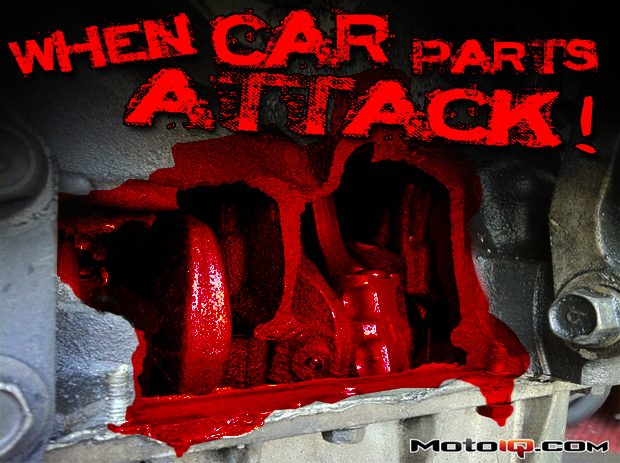 |
When Car Parts Attack – Drag Racing Safety Equipment
By Khiem Dinh
Khiem Dinh is an engineer for Honeywell Turbo Technologies at the time of this writing. All statements and opinions expressed by Khiem Dinh are solely those of Khiem Dinh and not reflective of Honeywell Turbo Technologies.
Racers push everything to the limit and often times beyond in their goals of being the fastest. To be the fastest, you have to make power. The more power you make, the more stress you apply to parts causing them to fail. If you want to test the durability of a part, put it in a race car and take it out to the track. What happens when a part does fail? Often times, those parts are spinning really fast meaning they have a lot of kinetic energy. When these parts fail, that energy gets released in every direction. If safety precautions are not taken, a lot of damage and death can be the result. Drag racers are particularly apt at breaking powertrain and drivetrain parts, so we’re going to examine a little bit of the physics and have a look at some of the safety measures.
Drag racing has a singular goal: get to the finish line first. In order to achieve that goal, maximum power and traction are required. According to Sir Isaac Newton's third law of motion, every action has an equal and opposite reaction. In terms of drag racing, and cars in general, the force the car is able to put down to the ground allowed by the given traction conditions has an equal force acting on every part of the drivetrain and powertrain. We all know this intuitively; if a car is on ice and has no traction, no force is being put down which equals no force on the drivetrain and powertrain components. The engine can create enough force to break parts, but since there is no traction, there is no force. Since there is no force between the tire and the ice, there's no equal and opposite force being applied to all the car parts. The opposite end of the spectrum is maximum traction. Many axles have been snapped into pieces from traction allowing all the force the engine could create to be put to the ground through the axles.
Broken drivetrain parts are due to the combination of Newton's third law of motion and his second law of motion: F = ma. A top fuel dragster gets to the 60' mark in about 0.8 seconds with a launch acceleration approaching 8G's; that level of acceleration is almost three times the maximum G force experienced on a space shuttle launch. Only fighter jet pilots experience G level forces the driver of a top fuel dragster is subjected to. Where am I going with this? Plug in 8G's worth of acceleration into Newton's second law, and you get HUGE forces. Huge forces combined with traction = broken parts.
In top fuel drag racing, the huge forces are created by big block engines and positive displacement (roots) superchargers. Every once in a while, a supercharger will blow up. Inside a roots blower are basically two long metal impellers spinning very very quickly. The kinetic energy of the impellers goes by the square of the rotational speed; so the faster parts spin, the kinetic energy goes up exponentially. To prevent supercharger shrapnel from flying out, supercharger Kevlar blankets have become mandatory safety equipment. These are basically bullet-proof vests to contain exploding car parts. Beneath the supercharger sits the engine of course. As many an automotive enthusiast can attest to, connecting rods also like to break and create large ventilation holes in the engine block. To keep all the metal bits contained, a Kevlar diaper is wrapped around the engine.
 |
| Visible between the intake/butterflies and the valve covers is the blower with Kevlar safety blanket surrounding it. |
 |
 |
Stroud Safety produces these SFI approved Kevlar engine diapers and transmission blankets.
On the backside of the engine are the flywheel and transmission. In addition to huge forces causing things to break, pure rotational speed can also cause parts to fail. If you spin something fast enough, it will come apart. Kevlar blankets are used on the transmission also should any gears and shafts decided they want to separate themselves from the rest of their friends and exit out the side of the transmission case.
Between the engine and transmission sits the flywheel. The flywheel is a big chunk of heavy metal that spins very quickly. When it also decides to check out of the party, it can cause massive damage and potential death. To prevent flywheel parts from impaling the driver or spectators, scatters shields are a safety item mandated in drag racing to contain the shrapnel. So just how much energy can a flywheel contain? We're going to find out.



